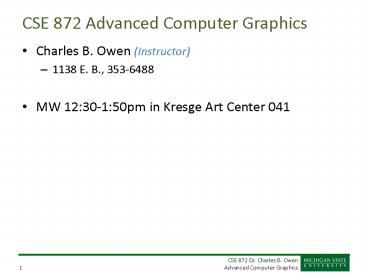CSE 872 Advanced Computer Graphics - PowerPoint PPT Presentation
Title:
CSE 872 Advanced Computer Graphics
Description:
Volume rendering and constructive solid geometry. Gaming and simulation ... Culling, depth testing. Lighting. Materials. What happens when you do glVertex? ... – PowerPoint PPT presentation
Number of Views:50
Avg rating:3.0/5.0
Title: CSE 872 Advanced Computer Graphics
1
CSE 872 Advanced Computer Graphics
- Charles B. Owen (Instructor)
- 1138 E. B., 353-6488
- MW 1230-150pm in Kresge Art Center 041
2
Introduction
- Introduction to the class
- Structure, rules, etc.
- Where do we stand?
- What you should know coming in or get caught up
on!
3
Course Content
- Basic and advanced modeling
- Scan conversion for photorealistic rendering
- Ray tracing and related methods
- Radiosity and hybrid methods
- Particle-based methods
- Physical modeling
- Water and fire
- Curves, splines, NURBS
4
Course Content
- Quaterians for computer graphics
- Computational geometry
- Non-photorealistic methods
- Volume rendering and constructive solid geometry
- Gaming and simulation
- Level of detail
- Augmented reality techniques
5
Course Content Anything else?
- Real time using hardware
- Pixel shaders
- Virtual reality
- Animation techniques
- Motion capture
- Post-production
6
Course Structure
- See the syllabus
7
Course Materials
- Textbooks
- Advanced Animation and Rendering Techniques, Alan
Watt, Mark Watt. ISBN 0-201-54412-1 - OpenGL Programming Guide, Fifth Edition,
Shreiner, Woo, Neider, and Davis, Addison Wesley,
ISBN 0-321-33573-2. (Optional) - WWW
- http//www.cse.msu.edu/cse872
- And on angel (angel.msu.edu)
8
Course Structure
- Paper review/presentation
- Explorations
- Project 1
- Project 2
- Project 3
- Class Participation
9
Where do we stand?
- What do we know about
- Configuring projection matrices
- Configuring modelview matrices
- Culling, depth testing
- Lighting
- Materials
- What happens when you do glVertex?
10
void CChildViewOnGLDraw(CDC pDC)
glClearColor(0.0f, 0.0f, 0.0f, 0.0f)
glClear(GL_COLOR_BUFFER_BIT GL_DEPTH_BUFFER_BIT)
// Set up the camera
glMatrixMode(GL_PROJECTION)
glLoadIdentity() // Determine the screen
size so we can determine the aspect ratio int
width, height GetSize(width, height)
// Set the camera parameters
gluPerspective(25., // Vertical field
of view in degrees.
GLdouble(width) / GLdouble(height), // The
aspect ratio. 10.,
// Near clipping 200.)
// Far clipping // Set the camera
location glMatrixMode(GL_MODELVIEW)
glLoadIdentity() gluLookAt(20., 10., 50.,
// eye x,y,z 0., 0., 0., //
center x,y,z 0., 1., 0.) // Up
direction
11
// Enable depth test glEnable(GL_DEPTH_TEST)
// Cull backfacing polygons
glCullFace(GL_BACK) glEnable(GL_CULL_FACE)
// Enable lighting glEnable(GL_LIGHTING)
glEnable(GL_LIGHT0) GLfloat lightpos
.5, 1, 1, 0. // GLfloat lightpos 10.,
10., 10., 1. glLightfv(GL_LIGHT0,
GL_POSITION, lightpos)
12
glPushMatrix() GLfloat white 0.8f,
0.8f, 0.8f, 1.0f GLfloat cyan 0.f, .8f,
.8f, 1.f glMaterialfv(GL_FRONT, GL_DIFFUSE,
cyan) glMaterialfv(GL_FRONT, GL_SPECULAR,
white) GLfloat shininess 100
glMaterialfv(GL_FRONT, GL_SHININESS,
shininess) glRotated(m_spinangle, 1, .5,
.7) Box(5, 5, 5) glPopMatrix()
glFlush()
13
void CChildViewBox(GLdouble p_x, GLdouble p_y,
GLdouble p_z) GLdouble a 0., 0., p_z
GLdouble e 0., 0., 0. GLdouble b
p_x, 0., p_z GLdouble f p_x, 0., 0.
GLdouble c p_x, p_y, p_z GLdouble g
p_x, p_y, 0. GLdouble d 0., p_y, p_z
GLdouble h 0., p_y, 0. // Front
glBegin(GL_QUADS) glNormal3d(0, 0, 1)
glVertex3dv(a) glVertex3dv(b)
glVertex3dv(c) glVertex3dv(d)
glEnd() // Right glBegin(GL_QUADS)
glNormal3d(1, 0, 0) glVertex3dv(c)
glVertex3dv(b) glVertex3dv(f)
glVertex3dv(g) glEnd()































